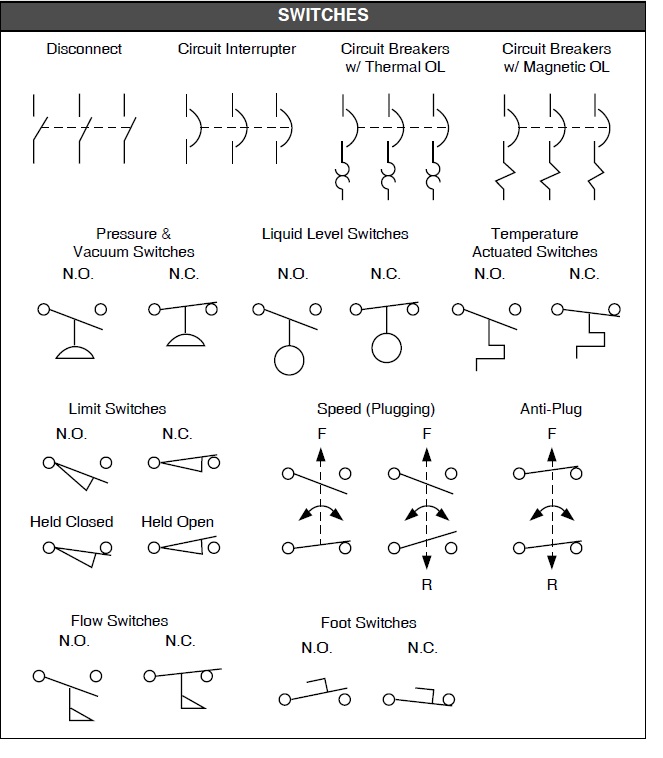Deciphering the Language of Circuits: A Guide to Wiring Diagram Switch Symbols
Imagine standing before a complex electrical panel, a network of wires and components creating a visual puzzle. The key to unlocking this puzzle lies in understanding the language of circuits: wiring diagram switch symbols. These seemingly simple markings hold the blueprint to the entire electrical system, guiding the flow of power and ensuring proper functionality.
Wiring diagrams, with their intricate network of lines and symbols, might seem daunting at first glance. However, these diagrams are essential tools for anyone working with electrical systems, from seasoned electricians to DIY enthusiasts. They provide a visual representation of the circuit's layout, indicating how different components are connected and how electricity flows through the system. Central to these diagrams are the switch symbols, which depict various types of switches and their functions.
The evolution of wiring diagram switch symbols reflects the advancements in electrical technology itself. Early diagrams were often rudimentary, using simple shapes and lines to represent components. As electrical systems became more complex, so did the symbols, evolving into standardized representations recognized internationally. This standardization is crucial for clear communication and collaboration among electricians worldwide, ensuring that a diagram created in one country can be easily interpreted in another.
The importance of correctly interpreting these symbols cannot be overstated. A misinterpretation of a single symbol can lead to faulty wiring, malfunctioning equipment, and even safety hazards. For example, confusing a normally open switch symbol with a normally closed one can result in a circuit that behaves unexpectedly, potentially causing damage or injury. Therefore, a thorough understanding of these symbols is paramount for anyone working with electrical systems.
Understanding switch symbols in wiring diagrams goes beyond simple identification. It involves grasping the underlying principles of how different switches operate and how they control the flow of electricity. This knowledge is essential for troubleshooting electrical issues, designing new circuits, and ensuring the safe and efficient operation of electrical systems. It’s about seeing the symbols not just as markings on a page, but as representations of real-world components that govern the flow of power.
A single-pole single-throw (SPST) switch, represented by a simple line with a perpendicular branch, controls a single circuit. A double-pole double-throw (DPDT) switch, depicted with two sets of parallel lines and interconnected branches, can control two separate circuits. Understanding these symbols and their variations is crucial for reading and interpreting wiring diagrams effectively.
Benefits of Understanding Wiring Diagram Switch Symbols:
1. Enhanced Safety: Accurate interpretation of symbols prevents wiring errors, minimizing the risk of electrical shocks and fires.
2. Efficient Troubleshooting: Understanding symbols helps quickly identify faulty components and resolve electrical issues.
3. Effective Communication: Standardized symbols facilitate clear communication among electricians and other professionals working with electrical systems.
Best Practices:
1. Always refer to a standardized symbol legend when interpreting wiring diagrams.
2. Double-check the meaning of unfamiliar symbols before proceeding with any electrical work.
3. Use high-quality diagrams with clear and accurate symbols.
4. Seek professional assistance if you are unsure about any aspect of the wiring diagram.
5. Keep updated with the latest revisions and updates to wiring diagram standards.
Frequently Asked Questions:
1. What does a circle with an "X" inside represent? (Answer: A normally closed switch)
2. How is a three-way switch represented? (Answer: By two interconnected switches with a common terminal)
3. Where can I find a comprehensive list of wiring diagram switch symbols? (Answer: Various online resources and electrical handbooks)
4. What is the difference between a momentary switch and a latching switch? (Answer: A momentary switch only closes the circuit while held, while a latching switch remains closed until manually opened.)
5. How do I interpret a diagram with multiple interconnected switches? (Answer: Trace the flow of electricity through each switch based on its position.)
6. What are some common mistakes to avoid when interpreting switch symbols? (Answer: Confusing normally open and normally closed switches, misinterpreting the number of poles and throws.)
7. How can I improve my understanding of wiring diagram switch symbols? (Answer: Study electrical textbooks, practice reading diagrams, and seek guidance from experienced electricians.)
8. Are there software tools available for creating and interpreting wiring diagrams? (Answer: Yes, several software programs specialize in creating and simulating electrical circuits.)
Tips and Tricks:
Use colored pencils or highlighters to trace the flow of electricity through different branches of the circuit. This can be particularly helpful when dealing with complex diagrams involving multiple switches.
In conclusion, the world of electrical systems is built upon a foundation of clear communication, and wiring diagram switch symbols are the essential vocabulary of this language. From the simplest single-pole switch to the most complex multi-pole configurations, understanding these symbols empowers us to safely and effectively interact with the flow of electricity. Mastering this language not only enhances our ability to troubleshoot and repair electrical systems but also opens up possibilities for designing and implementing innovative circuits. Embrace the challenge of deciphering these symbols, and you’ll unlock a deeper understanding of the intricate world of electricity, empowering you to navigate the circuits that power our modern lives. By prioritizing accurate interpretation and adhering to best practices, we can ensure the safety, efficiency, and reliability of the electrical systems that surround us.
Decoding the white dog sniffing meme phenomenon
Upgrade your oasis contemporary master bathroom shower designs
Unlocking your dream car navigating the carmax sterling used car experience














